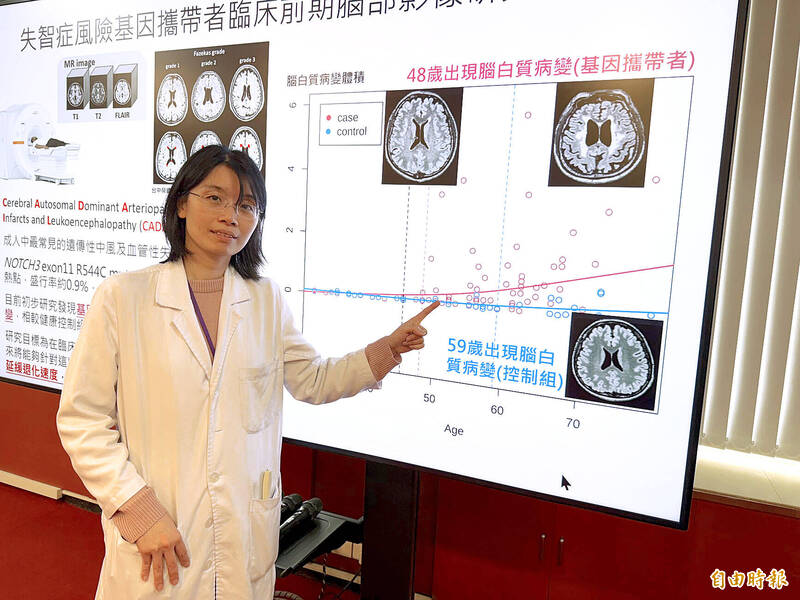《TAIPEI TIMES》Gene variation leads to higher risk of dementia

Taichung Veterans General Hospital doctor Tung Hsin points to a slide showing the pathological changes in progressive multifocal leukoencephalopathy in Taichung on Thursday. Photo: Tsai Shu-yuan, Taipei Times
NEW RESEARCH: About 28 percent of patients with the R544C variant in the Notch-3 gene have been diagnosed with dementia or have suffered a stroke, a doctor said
By Tsai Shu-yuan and Jake Chung / Staff reporter, with staff writer
Research conducted by Veterans General Hospital’s Taichung branch shows that a particular genetic variation, specific to Taiwanese, leads to a higher risk of stroke and dementia, and warned that families with a history of strokes or hyperlipidemia should be on the alert.
Department of Neurology doctor Tung Hsin (董欣) said the R544C variant in the Notch-3 gene is a common variant for Taiwanese and is considered a cause of cerebral autosomal dominant arteriopathy with subcortical infarcts and leukoencephalopathy.
If either parent carries the gene variation, their offspring would have a 50/50 chance of inheriting the gene variation, Tung said.
The genetic variation causes congenital fragility of blood vessel walls, and people who have it should control their lipedema levels.
Tung said past research showed that patients were usually diagnosed with the symptoms at the age of 54 to 56.
People with the gene variation could experience general leukoencephalopathy, cerebral infarction and a minute brain hemorrhage from the progressive buildup of cerebral white matter as they age, resulting in a decrease in cognitive and memory functions.
Head of the hospital’s center for dementia Kee Wei-ju (李威儒) said the center’s research team combed through the hospital’s archives, established during the hospital’s participation in the nation’s Precision Medicine Initiative, and found that there were 554 patients with the R544C variation, or a prevalence rate of 0.96 percent.
About 28 percent of patients with the gene variation have been diagnosed with dementia or have suffered a stroke, while the remaining 72 percent, while visibly healthy, have also demonstrated higher rates of leukoencephalopathy compared with patients without the gene variation, Kee said.
The team conducted neuroimaging for 63 patients with the gene variation without visible symptoms, and 37 people without the gene variation, showing that those with the gene variation experienced increased rates of leukoencephalopathy — comprising 0.336 percent of the cerebral mass — after the age of 48, higher than the 0.059 percent of those without the gene variation.
Lee said the research suggests that those with the gene variation experience increased rates of leukoencephalopathy 10 years before those without the gene variation and six to seven years before noticeable symptoms develop.
新聞來源:TAIPEI TIMES














